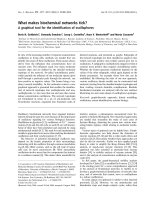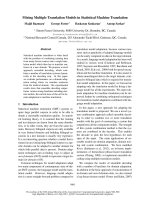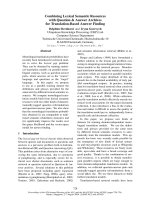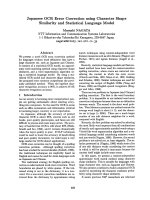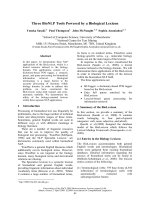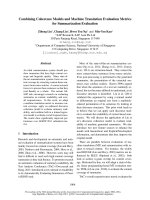Báo cáo khoa học: "Combining Multiple, Large-Scale Resources in a Reusable Lexicon for Natural Language Generation" pptx
Bạn đang xem bản rút gọn của tài liệu. Xem và tải ngay bản đầy đủ của tài liệu tại đây (676.13 KB, 7 trang )
Combining Multiple, Large-Scale Resources in a Reusable Lexicon
for Natural Language Generation
Hongyan Jing and Kathleen McKeown
Department of Computer Science
Columbia University
New York, NY 10027, USA
{hjing, kathy} @cs.columbia.edu
Abstract
A lexicon is an essential component in a gener-
ation system but few efforts have been made
to build a rich, large-scale lexicon and make
it reusable for different generation applications.
In this paper, we describe our work to build
such a lexicon by combining multiple, heteroge-
neous linguistic resources which have been de-
veloped for other purposes. Novel transforma-
tion and integration of resources is required to
reuse them for generation. We also applied the
lexicon to the lexical choice and realization com-
ponent of a practical generation application by
using a multi-level feedback architecture. The
integration of the lexicon and the architecture
is able to effectively improve the system para-
phrasing power, minimize the chance of gram-
matical errors, and simplify the development
process substantially.
1 Introduction
Every generation system needs a lexicon, and in
almost every case, it is acquired anew. Few ef-
forts in building a rich, large-scale, and reusable
generation lexicon have been presented in liter-
ature. Most generation systems are still sup-
ported by a small system lexicon, with limited
entries and hand-coded knowledge. Although
such lexicons are reported to be sufficient for
the specific domain in which a generation sys-
tem works, there are some obvious deficiencies:
(1) Hand-coding is time and labor intensive, and
introduction of errors is likely. (2) Even though
some knowledge, such as syntactic structures
for a verb, is domain-independent, often it is
re-encoded each time a new application is un-
der development. (3) Hand-coding seriously re-
stricts the scale and expressive power of gener-
ation systems. As natural language generation
is used in more ambitious applications, this sit-
uation calls for an improvement.
Generally, existing linguistic resources are not
suitable to use for generation directly. First,
most large-scale linguistic resources so far were
built for language interpretation applications.
They are indexed by words, whereas, an ideal
generation lexicon should be indexed by the se-
mantic concepts to be conveyed, because the in-
put of a generation system is at semantic level
and the processing during generation is based
on semantic concepts, and because the mapping
in the generation process is from concepts to
words. Second, the knowledge needed for gen-
eration exists in a number of different resources,
with each resource containing a particular type
of information; they can not currently be used
simultaneously in a system.
In this paper, we present work in building a
rich, large-scale, and reusable lexicon for gener-
ation by combining multiple, heterogeneous lin-
guistic resources. The resulting lexicon contains
syntactic, semantic, and lexical knowledge, in-
dexed by senses of words as required by gener-
ation, including:
A complete list of syntactic subcategoriza-
tions for each sense of a verb to support
surface realization.
A large variety of transitivity alternations
for each sense of a verb to support para-
phrasing.
Frequency of lexical items and verb subcat-
egorizations and also selectional constraints
derived from a corpus to support lexical
choice.
Rich lexical relations between lexical con-
cepts, including hyponymy, antonymy, and
so on, to support lexical choice.
607
The construction of the lexicon is semi-
automatic, and the lexicon has been used for
lexical choice and realization in a practical gen-
eration system. In Section 2, we describe the
process to build the generation lexicon by com-
bining existing linguistic resources. In Section
3, we show the application of the lexicon by ac-
tually using it in a generation system. Finally,
we present conclusions and future work.
2 Constructing a generation lexicon
by merging linguistic resources
2.1 Linguistic resources
In our selection of resources, we aim primarily
for accuracy of the resource, large coverage, and
providing a particular type of information es-
pecially useful for natural language generation.
four linguistic resources:
1. The WordNet on-line lexical database
(Miller et al., 1990). WordNet is a well
known on-line dictionary, consisting of
121,962 unique words, 99,642 synsets (each
synset is a lexical concept represented by
a set of synonymous words), and 173,941
senses of words. 1 It is especially useful for
generation because it is based on lexical
concepts, rather than words, and because
it provides several semantic relationships
(hyponymy, antonymy, meronymy, entail-
ment) which are beneficial to lexical choice.
2. English Verb Classes and Alternations
(EVCA) (Levin, 1993). EVCA is an ex-
tensive linguistic study of diathesis alter-
nations, which are variations in the realiza-
tion of verb arguments. For example, the
alternation "there-insertion" transforms A
ship appeared on the horizon to There ap-
peared a ship on the horizon. Knowledge
of alternations facilitates the generation of
paraphrases. (Levin, 1993) studies 80 al-
ternations.
3. The COMLEX syntax dictionary (Grish-
man et al., 1994). COMLEX contains
syntactic information for 38,000 English
words. The information includes subcat-
egorization and complement restrictions.
4. The Brown Corpus tagged with WordNet
senses (Miller et al., 1993). The original
1As of Version 1.6, released in December 1997.
Brown corpus (Ku~era and Francis, 1967)
has been used as a reference corpus in many
computational applications. Part of Brown
Corpus has been tagged with WordNet
senses manually by the WordNet group.
We use this corpus for frequency measure-
ments and exacting selectional constraints.
2.2 Combining linguistic resources
In this section, we present an algorithm for
merging data from the four resources in a man-
ner that achieves high accuracy and complete-
ness. We focus on verbs, which play the most
important role in deciding phrase and sentence
structure.
Our algorithm first merges COMLEX and
EVCA, producing a list of syntactic subcate~
gorizations and alternations for each verb. Dis-
tinctions in these syntactic restrictions accord-
ing to each sense of a verb are achieved in the
second stage, where WordNet is merged with
the result of the first step. Finally, the corpus
information is added, complementing the static
resources with actual usage counts for each syn-
tactic pattern. This allows us to detect rarely
used constructs that should be avoided during
generation, and possibly to identify alternatives
that are not included in the lexical databases.
2.2.1 Merging COMLEX and EVCA
Alternations involve syntactic transformations
of verb arguments. They are thus a means to
alleviate the usual lack of alternative ways to
express the same concept in current generation
systems.
EVCA has been designed for use by humans,
not computers. We need therefore to convert
the information present in Levin's book (Levin,
1993) to a format that can be automatically
analyzed. We extracted the relevant informa-
tion for each verb using the verb classes to
which the various verbs are assigned; members
of the same class have the same syntactic behav-
ior in terms of allowable alternations. EVCA
specifies a mapping between words and word
classes, associating each class with alternations
and with subcategorization frames. Using the
mapping from word and word classes, and from
word classes to alternations, alternations for
each verb are extracted.
We manually formatted the alternate pat-
terns in each alternation in COMLEX format.
608
The reason to choose manual formatting rather
than automating the process is to guarantee
the reliability of the result. In terms of time,
manual formatting process is no more expensive
than automation since the total number of alter-
nations is smail(80). When an alternate pattern
can not be represented by the labels in COM-
LEX, we need to added new labels during the
formatting process; this also makes automating
the process difficult.
The formatted EVCA consists of sets of ap-
plicable alternations and subcategorizations for
3,104 verbs. We show the sample entry for the
verb
appear
in Figure 1. Each verb has 1.9 alter-
nations and 2.4 subcategorizations on average.
The maximum number of alternations (13) is
realized for the verb "roll".
The merging of COMLEX and EVCA is
achieved by unification, which is possible due
to the usage of similar representations. Two
points are worth to mention: (a) When a more
general form is unified with a specific one, the
later is adopted in final result. For example, the
unification of PP2 and PP-PRED-RS 3 is PP-
PRED-RS. (b) Alternations are validated by the
subcategorization information. An alternation
is applicable only if both alternate patterns are
applicable.
Applying this algorithm to our lexical re-
sources, we obtain rich subcategorization and
alternation information for each verb. COM-
LEX provides most subcategorizations, while
EVCA provides certain rare usages of a verb
which might be missing from COMLEX. Con-
versely, the alternations in EVCA are validated
by the subcategorizations in COMLEX. The
merging operation produces entries for 5,920
verbs out of 5,583 in COMLEX and 3,104 in
EVCA. 4 Each of these verbs is associated with
5.2 subcategorizations and 1.0 alternation on
average. Figure 2 is an updated version of Fig-
ure 1 after this merging operation.
2.2.2 Merging COMLEX/EVCA with
WordNet
WordNet is a valuable resource for generation
because most importantly the synsets provide
2The verb can take a prepositional phrase
SThe verb can take a prepositional phrase, and the
subject of the prepositional phrase is the same as the
verb's
42,947 words appear in both resources.
appear:
((INTm%NS)
(LOCPP)
(pp)
(ADJ-PFA-PART)
(INTKANS THEKE-V-SUBJ :ALT There-Insertion)
(LOCPP THEKE-V-SUBJ-LOCPP :ALT There-Insertion)
(LOCPP LOCPP-V-SUBJ :ALT Locative_Inversion))
Figure h Alternations and subcategorizations
from EVCA for the verb
appear.
~ppefl~r:
((PP-T0-INF-KS :PVAL ("to"))
(PP-PKED-RS :PVAL ("to of" "under against"
"in favor of' ' "before" "at"))
(EXTRAP-T0-NP-S)
(INTRANS)
(INTRANS THERE-V-SUBJ :ALT There-Insertion)
(L0CPP THEKE-V-SUBJ-L0CPP :ALT There-Insertion)
(LOCPP L0CPP-V-SUBJ :ALT Locative_Inversion)))
Figure 2: Entry for the verb
appear
after merg-
ing COMLEX with EVCA.
a mapping between concepts and words. Its in-
clusion of rich lexical relations also provide basis
for lexical choice. Despite of these advantages,
the syntactic information in WordNet is rela-
tively poor. Conversely, the result we obtained
after combining COMLEX and EVCA has rich
syntactic information, but this information is
provided at word level thus unsuitable to use
for generation directly. These complementary
resources are therefore combined in the second
stage, where the subcategorizations and alter-
nations from COMLEX/EVCA for each word
are assigned to each sense of the word.
Each synset in WordNet is linked with a list
of verb frames, each of which represents a sim-
ple syntactic pattern and general semantic con-
straints on verb arguments, e.g.,
Somebody -s
something.
The fact that WordNet contains this
syntactic information(albeit poor) makes it pos-
sible to link the result from COMLEX/EVCA
with WordNet.
The merging operation is based on a compat-
ibility matrix, which indicates the compatibility
of each subcategorization in COMLEX/EVCA
with each verb frame in WordNet. The sub-
609
categorizations and alternations listed in COM-
LEX/EVCA for each word is then assigned to
different senses of the word based on their com-
patibility with the verbs frames listed under
that sense of the word in WordNet. For exam-
ple, if for a certain word, the subcategorizations
PP-PRED-RS and NP are listed for the word
in COMLEX/EVCA, and the verb frame some-
body -s PP is listed for the first sense of the
word in WordNet, then PP-PRED-RS will be
assigned to the first sense of the word while NP
will not. We also keep in the lexicon the gen-
eral constraint on verb arguments from Word-
Net frames. Therefore, for this example, the
entry for the first sense of w indicates that the
verb can take a prepositional phrase as a com-
plement, the subject of the verb is the same
as the subject of the prepositional phrase, and
the subject should be in the semantic category
"somebody". As you can see, the result incorpo-
rates information from three resources and but
is more informative than any of them. An alter-
nation is considered applicable to a word sense
if both alternate patterns have matchable verb
frames under that sense.
The compatibility matrix is the kernel of the
merging operations. The 147"35 matrix (147
subcategorizations from COMLEX/EVCA, 35
verb frames from WordNet) was first manually
constructed based on human understanding. In
order to achieve high accuracy, the restrictions
to decide whether a pair of labels are compatible
are very strict when the matrix was first con-
structed. We then use regressive testing to ad-
just the matrix based on the analysis of merging
results. During regressive testing, we first merge
WordNet with COMLEX/EVCA using current
version of compatibility matrix, and write all
inconsistencies to a log file. In our case, an in-
consistency occurs if a subcategorization or al-
ternation in COMLEX/EVCA for a word can
not be assigned to any sense of the word, or
a verb frame for a word sense does not match
any subcategorization for that word. We then
analyze the log file and adjust the compatibil-
ity matrix accordingly. This process repeated
6 times until when we analyze a fair amount of
inconsistencies in the log file, they are no more
due to over-restriction of the compatibility ma-
trix.
Inconsistencies between WordNet and COM-
appear:
sense
1 give an impression
((PP-T0-INF-RS :PVAL ("to") :SO ((sb, -)))
(TO-INF-RS :SO ((sb, -)))
(NP-PRED-RS :SO ((sb, -)))
(ADJP-PRED-RS :$0 ((sb, -) (sth, -)))))
sense
2 become visible
((PP-TO-INF-RS :PVAL ("to")
:SO ((sb, ) (sth, -)))
o,,
(INTRANS THERE-V-SUBJ
: ALT there-insertion
:SO ((sb, -) (sth, -))))
sense
8 have an outward expression
((NP-PRED-RS :SO ((sth, -)))
(ADJP-PRED-RS :SO ((sb, -) (sth, -))))
Figure 3: Entry for the verb appear after merg-
ing WordNet with the result from COMLEX
and EVCA.
LEX/EVCA result unmatching subcategoriza-
tions or verb frames. On average, 15% of sub-
categorizations and alternations for a word can
not be assigned to any sense of the word, mostly
due to the incompleteness of syntactic informa-
tion in WordNet; 2% verb frames for each sense
of a word does not match any subcategoriza-
tions for the word, either due to incomplete-
ness of COMLEX/EVCA or erroneous entries
in WordNet.
The lexicon at this stage is a rich set of sub-
categorizations and alternations for each sense
of a word, coupled with semantic constraints of
verb arguments. For 5,920 words in the result
after combining COMLEX and EVCA, 5,676
words also appear in WordNet and each word
has 2.5 senses on average. After the merging
operation, the average number of subcatego-
rizations is refined from 5.2 per verb in COM-
LEX/EVCA to 3.1 per sense, and the average
number of alternations is refined from 1.0 per
verb to 0.2 per sense. Figure 3 shows the result
for the verb appear after the merging operation.
2.3 Corpus analysis
Finally, we enriched the lexicon with language
usage information derived from corpus analy-
sis. The corpus used here is the Brown Corpus.
The language usage information in the lexicon
include: (1) frequency of each word sense; (2)
frequency of subcategorizations for each word
sense. A parser is used to recognize the subcat-
egorization of a verb. The corpus analysis in-
610
formation complements the subcategorizations
from the static resources by marking potential
superfluous entries and supplying entries that
are possibly missing in the lexicai databases; (3)
semantic constraints of verb arguments. The
arguments of each verb are clustered based on
hyponymy hierarchy in WordNet. The seman-
tic categories we thus obtained are more specific
compared to the general constraint(animate or
inanimate) encoded in WordNet frame represen-
tation. The language usage information is espe-
cially useful in lexicai choice.
2.4 Discussion
Merging resources is not a new idea and pre-
vious work has investigated integration of re-
sources for machine translation and interpreta-
tion (Klavans et al., 1991), (Knight and Luk,
1994). Whereas our work differs from previ-
ous work in that for the first time, a generation
lexicon is built by this technique; unlike other
work which aims to combine resources with sim-
ilar type of information, we select and combine
multiple resources containing different types of
information; while others combine not well for-
matted lexicon like LDOCE (Longman Dictio-
nary of Contemporary English), we chose well
formatted resources (or manually format the re-
source) so as to get reliable and usable results;
semi-automatic rather than fully automatic ap-
proach is adopted to ensure accuracy; corpus
analysis based information is also linked with
information from static resources. By these
measures, we are able to acquire an accurate,
reusable, rich, and large-scale lexicon for natu-
ral language generation.
3 Applications
3.1
Architecture
We applied the lexicon to lexical choice and
lexical realization in a practical generation sys-
tem. First we introduce the architecture of lexi-
cal choice and realization and then describe the
overall system.
A multi-level feedback architecture as shown
in Figure 4 was used for lexical choice and real-
ization. We distinguish two types of concepts:
semantic concepts and lexicai concepts. A se-
mantic concept is the semantic meaning that a
user wants to convey, while a lexical concept is a
lexical meaning that can be represented by a set
I Sentence Planner I
~i uoncepts to Le×ical
Concepts
11
~01 Lexical
Concepts
"~}
[ Mapping from Lexicall i~
~ii [ Concepts to Words [ ~rdNe)
~Generafi~o
and Syntactic Paraphrases
~
[ Surface Realizatio~
Natural Language Output
Figure 4: The Architecture for Lexical Choice
and Realization
of synonymous words, such as synsets defined in
WordNet. Paraphrases are also distinguished
into 3 types according to whether they are at
the semantic, lexical, or syntactic level. For ex-
ample, if asked whether you will be at home
tomorrow, then the answers "I'll be at work to-
morrow", "No, I won't be at home.', and "I'm
leaving for vacation tonight" are paraphrases at
the semantic level. Paraphrases like "He bought
an umbrella" and "He purchased an umbrella"
are at the lexical level since they are acquired
by substituting certain words with synonymous
words. Paraphrases like "A ship appeared on
the horizon" and "On the horizon appeared a
ship" are at the syntactic level since they only
involve syntactic transformations. Therefore,
all paraphrases introduced by alternations are
at syntactic level. Our architecture includes lev-
els corresponding to these 3 levels of paraphras-
ing.
The input to the lexical choice and realiza-
tion module is represented as semantic concepts.
In the first stage, semantic paraphrasing is car-
ried out by mapping semantic concepts to lex-
ical concepts. Generally, semantic level para-
phrases are very complex. They depend on the
611
situation, the domain, and the semantic rela-
tions involved. Semantic paraphrases are repre-
sented declaratively in a database file which can
be edited by the users. The file is indexed by
semantic concepts and under each entry, a list
of lexical concepts that can be used to realize
the semantic concept are provided.
In the second stage, we use the lexical re-
source that we constructed to choose words for
the lexical concepts produced by stage 1. The
lexicon is indexed by lexical concepts that point
to synsets in WordNet. These synsets repre-
sent a set of synonymous words and thus, it is
at this stage that lexical paraphrasing is han-
dled. In order to choose which word to use for
the lexical concept, we use domain-independent
constraints that are included in the lexicon as
well as domain-specific constraints. Syntactic
constraints that come from the detailed sub-
categorizations linked to each word sense is a
domain-independent constraint. Subcategoriza-
tions are used to check that the input can be
realized by the word. For example, if the in-
put has 3 arguments, then words which take
only 2 arguments can not be selected. Seman-
tic constraints on verb argument derived from
WordNet and the corpus are used to check the
agreement of the arguments. For example, if
the input subject argument is an animate, then
words which take only inanimate subject can
not be selected. Frequency information derived
from the corpus is also used to constrain word
choice. Besides the above domain-independent
constraints other constraints specific to a do-
main might also be needed to choose an ap-
propriate word for the lexical concept. Intro-
ducing the combined lexicon at this stage al-
lows us to produce many lexical paraphrases
without much effort; it also allows us to sep-
arate domain-independent and domain-specific
constraints in lexical choice so that domain-
independent constraints can be reused in each
application.
The third stage produces a structure repre-
sented as a high level sentence structure, with
subcategorizations and words associated with
each sentence. At this stage, information in
the lexical resource about subcategorization and
alternations are applied in order to generate
syntactic paraphrases. Output of this stage is
then fed directly to the surface realization pack-
age, the FUF/SURGE system (Elhadad, 1992;
Robin, 1994). To choose which alternate pat-
tern of an alternation to use, we use information
such as focus of the sentence as criteria; when
the two alternates are not distinctively different,
such as "He knocked the door" and "He knocked
at the door", one of them is randomly chosen.
The application of subcategorizations in the lex-
icon at this stage helps to check that the output
is grammatically correct, and alternations can
produce many syntactic paraphrases.
The above refining processing is interactive.
When a lower level can not find a possible can-
didate to realize the high level representation,
feedback is sent to the higher level module,
which then makes changes accordingly.
3.2 PlanDOC
Using the proposed architecture, we applied the
lexicon to a practical generation system, PIan-
DOC. PlanDOC is an enhancement to Bell-
core's LEIS-PLAN
TM
network planning prod-
uct. It transforms lengthy execution traces
of engineer's interaction with LEIX-PLAN into
human-readable summaries.
For each message in PlanDOC, at least 3
paraphrases are defined at semantic level. For
example, '~rhe base plan called for one fiber ac-
tivation at CSA 2100" and "There was one fiber
activation at CSA 2100" are semantic para-
phrases in PlanDOC domain. At the lexical
level, we use synonymous words from WordNet
to generate lexical paraphrases. A sample lexi-
cal paraphrase for "The base plan called for one
fiber activation at CSA 2100" is "The base plan
proposed one fiber activation at CSA 2100".
Subcategorizations and alternations from the
lexicon are then applied at the syntactic level.
After three levels of paraphrasing, each mes-
sage in PlanDOC on average has over 10 para-
phrases.
For a specific domain such as PlanDOC, an
enormous proportion of a general lexicon like
the one we constructed is unrelated thus un-
used at all. On the other hand, domain-specific
knowledge may need to be added to the lexicon.
The problem of how to adapt a general lexicon
to a particular application domain and merge
domain ontologies with a general lexicon is out
of the scope of this paper but discussed in (Jing,
1998).
612
4 Conclusion
In this paper, we present research on building a
rich, large-scale, and reusable lexicon for gener-
ation by combining multiple heterogeneous lin-
guistic resources. Novel semi-automatic trans-
formation and integration were used in combin-
ing resources to ensure reliability of the result-
ing lexicon. The lexicon, together with a multi-
level feedback architecture, is used in a practical
generation system, PlanDOC.
The application of the lexicon in a generation
system such as PlanDOC has many advantages.
First, paraphrasing power of the system can be
greatly improved due to the introduction of syn-
onyms at the lexical concept level and alterna-
tions at the syntactic level. Second, the integra-
tion of the lexicon and the flexible architecture
enables us to separate the domain-dependent
component of the lexical choice module from
domain-independent components so they can
be reused. Third, the integration of the lexi-
con with the surface realization system helps in
checking for grammatical errors and also sim-
plifies the interface input to the realization sys-
tem. For these reasons, we were able to develop
PlanDOC system in a short time.
Although the lexicon was developed for gen-
eration, it can be applied in other applications
too. For example, the syntactic-semantic con-
straints can be used for word sense disambigua-
tion (Jing et al., 1997); The subcategoriza-
tion and alternations from EVCA/COMLEX
are better resources for parsing; WordNet en-
riched with syntactic information might also be
of value to many other applications.
Acknowledgment
This material is based upon work supported by
the National Science Foundation under Grant
No. IRI 96-19124, IRI 96-18797 and by a grant
from Columbia University's Strategic Initiative
Fund. Any opinions, findings, and conclusions
or recommendations expressed in this material
are those of the authors and do not necessarily
reflect the views of the National Science Foun-
dation.
References
Michael Elhadad. 1992.
Using Argumenta-
tion to Control Lexical Choice: A Functional
Unification-Based Approach.
Ph.D. thesis,
Department of Computer Science, Columbia
University.
Ralph Grishman, Catherine Macleod, and
Adam Meyers. 1994. COMLEX syntax:
Building a computational lexicon. In
Proceed-
ings of COLING'9$,
Kyoto, Japan.
Hongyan Jing, Vasileios Hatzivassilogiou, Re-
becca Passonneau, and Kathleen McKeown.
1997. Investigating complementary methods
for verb sense pruning. In
Proceedings of
A NL P '97 Lexical Semantics Workshop,
pages
58-65, Washington, D.C., April.
Hongyan Jing. 1998. Applying wordnet to nat-
ural language generation. In
To appear in
the Proceedings of COLING-ACL'98 work-
shop on the Usage of WordNet in Natural
Language Processing Systems,
University of
Montreal, Montreal, Canada, August.
J. Klavans, R. Byrd, N. Wacholder, and
M. Chodorow. 1991. Taxonomy and poly-
semy. Technical Report Research Report RC
16443, IBM Research Division, T.J. Wat-
son Research Center, Yorktown Heights, NY
10598.
Kevin Knight and Steve K. Luk. 1994. Build-
ing a large-scale knowledge base for machine
translation. In
Proceedings of AAAI'9,~.
H Ku6era and W. N. Francis. 1967.
Computa-
tional Analysis of Present-day American En-
glish.
Brown University Press, Providence,
RI.
Beth Levin. 1993.
English Verb Classes and
Alternations: A Preliminary Investigation.
University of Chicago Press, Chicago, Illinois.
George A. Miller, Richard Beckwith, Christiane
Fellbaum, Derek Gross, and Katherine J.
Miller. 1990. Introduction to WordNet: An
on-line lexical database.
International Jour-
nal of Lexicography (special issue),
3(4):235-
312.
George A. Miller, Claudia Leacock, Randee
Tengi, and Ross T. Bunker. 1993. A semantic
concordance. Cognitive Science Laboratory,
Princeton University.
Jacques Robin. 1994.
Revision-Based Gener-
ation of Natural Language Summaries Pro-
riding Historical Background: Corpus-Based
Analysis, Design, Implementation, and Eval-
uation.
Ph.D. thesis, Department of Com-
puter Science, Columbia University. Also
Technical Report CU-CS-034-94.
613


